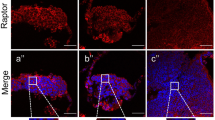Abstract
The Wnt/β-catenin pathway participates in many important physiological events such as cell proliferation and differentiation in the male reproductive system. We found that Kinesin-2 motor KIF3A is highly expressed during spermatogenesis in Eriocheir sinensis; it may potentially promote the intracellular transport of cargoes in this process. However, only a few studies have focused on the relationship between KIF3A and the Wnt/β-catenin pathway in the male reproductive system of decapod crustaceans. In this study, we cloned and characterized the CDS of β-catenin in E. sinensis for the first time. Fluorescence in situ hybridization and immunofluorescence results showed the colocalization of Es-KIF3A and Es-β-catenin at the mRNA and the protein level respectively. To further explore the regulatory function of Es-KIF3A to the Wnt/β-catenin pathway, the es-kif3a was knocked down by double-stranded RNA (dsRNA) in vivo and in primary cultured cells in testes of E. sinensis. Results showed that the expression of es-β-catenin and es-dvl were decreased in the es-kif3a knockdown group. The protein expression level of Es-β-catenin was also reduced and the location of Es-β-catenin was changed from nucleus to cytoplasm in the late stage of spermatogenesis when es-kif3a was knocked down. Besides, the co-IP result demonstrated that Es-KIF3A could bind with Es-β-catenin. In summary, this study indicates that Es-KIF3A can positively regulate the Wnt/β-catenin pathway during spermatogenesis and Es-KIF3A can bind with Es-β-catenin to facilitate the nuclear translocation of Es-β-catenin.







Similar content being viewed by others
References
Bialecka M, Young T, Chuva de Sousa Lopes S, ten Berge D, Sanders A, Beck F, Deschamps J (2012) Cdx2 contributes to the expansion of the early primordial germ cell population in the mouse. Dev Biol 371(2):227–234
Chassot AA, Le Rolle M, Jourden M, Taketo MM, Ghyselinck NB, Chaboissier MC (2017) Constitutive WNT/CTNNB1 activation triggers spermatogonial stem cell proliferation and germ cell depletion. Dev Biol 426(1):17–27
Dang R, Zhu JQ, Tan FQ, Wang W, Zhou H, Yang WX (2012) Molecular characterization of a KIF3B-like kinesin gene in the testis of Octopus tankahkeei (Cephalopoda, Octopus). Mol Biol Rep 39:5589–5598
Dores C, Alpaugh W, Dobrinski I (2012) From in vitro culture to in vivo models to study testis development and spermatogenesis. Cell Tissue Res 349:691–702
Du NS, Xue LZ, Lai W (1988) Studies on the sperm of Chinese mitten-handed crab, Eriocheir sinensis (Crustacea, Decapoda). II. Spermatogenesis. Oceanol Limnol Sin 19:71–75
Ewen KA, Koopman P (2010) Mouse germ cell development: from specification to sex determination. Mol Cell Endocrinol 323:76–93
Fan YS, Hu YJ, Yang WX (2012) TGF-beta superfamily: how does it regulate testis development. Mol Biol Rep 39(4):4727–4741
Gerdes JM, Liu Y, Zaghloul NA, Leitch CC, Lawson SS, Kato M, Beachy PA, Beales PL, DeMartino GN, Fisher S, Badano JL, Katsanis N (2007) Disruption of the basal body compromises proteasomal function and perturbs intracellular Wnt response. Nat Genet 39(11):1350–1360
Gilbertson RJ, Ellison DW (2008) The origins of medulloblastoma subtypes. Annu Rev Pathol 3:341–365
He X (2008) Cilia put a brake on wnt signaling. Nat Cell Biol 10(1):11–13
Kerr GE, Young JC, Horvay K, Abud HE, Loveland KL (2014) Regulated Wnt/beta-catenin signaling sustains adult spermatogenesis in mice. Biol Reprod 90:3–14
Koch S, Acebron SP, Herbst J, Hatiboglu G, Niehrs C (2015) Post-transcriptional Wnt signaling governs epididymal sperm maturation. Cell 163(5):1225–1236
Kumamoto N, Gu Y, Wang J, Janoschka S, Takemaru K, Levine J, Ge S (2012) A role for primary cilia in glutamatergic synaptic integration of adult-born neurons. Nat Neurosci 15(3):399–405
Liu J, Ren L, Wei J, Zhang J, Zhu Y, Li X, Jing L, Duan J, Zhou X, Sun Z (2018) Fine particle matter disrupts the blood-testis barrier by activating TGF-β3/p38 MAPK pathway and decreasing testosterone secretion in rat. Environ Toxicol 33(7):711–719
Liu Z, Rebowe RE, Wang Z, Li Y, Wang Z, DePaolo JS, Guo J, Qian C, Liu W (2014) KIF3a promotes proliferation and invasion via Wnt signaling in advanced prostate cancer. Mol Cancer Res 12(4):491–503
Liu ZQ, Jiang XH, Qi HY, Xiong LW, Qiu GF (2016) A novel SoxB2 gene is required for maturation of sperm nucleus during spermiogenesis in the Chinese mitten crab, Eriocheir sinensis. Sci Rep 6:32139
Logan CY, Nusse R (2004) The Wnt signaling pathway in development and disease. Annu Rev Cell Dev Biol 20:781–810
Lombardi AP, Royer C, Pisolato R, Cavalcanti FN, Lucas TF, Lazari MF, Porto CS (2013) Physiopathological aspects of the Wnt/beta-catenin signaling pathway in the male reproductive system. Spermatogenesis 3(1):e23181
Lu Y, Wang Q, Wang DH, Zhou H, Hu YJ, Yang WX (2014) Functional analysis of KIF3A and KIF3B during spermiogenesis of Chinese mitten crab Eriocheir sinensis. PLoS One 9(5):e97645
Massinen S, Hokkanen ME, Matsson H, Tammimies K, Tapia-Páez I, Dahlström-Heuser V, Kuja-Panula J, Burghoorn J, Jeppsson KE, Swoboda P, Peyrard-Janvid M, Toftgård R, Castrén E, Kere J (2011) Increased expression of the dyslexia candidate gene DCDC2 affects length and signaling of primary cilia in neurons. PLoS One 6(6):e20580
Nicol B, Guiguen Y (2011) Expression profiling of Wnt signaling genes during gonadal differentiation and gametogenesis in rainbow trout. Sex Dev 5(6):318–329
Nusse R (2012) Wnt signaling. Cold Spring Harb Perspect Biol. https://doi.org/10.1101/cshperspect.a011163
Nusse R, Varmus HE (1982) Many tumors induced by the mouse mammary tumor virus contain a provirus integrated in the same region of the host genome. Cell 31:99–109
Polakis P (2000) Wnt signaling and cancer. Genes Dev 14:1837–1851
Schock EN, Brugmann SA (2017) Neural crest cells utilize primary cilia to regulate ventral forebrain morphogenesis via hedgehog-dependent regulation of oriented cell division. Dev Biol 431(2):168–178
Shen X, Niu C, Guo J, Xia M, Xia J, Hu Y, Zheng Y (2018) Stra8 may inhibit apoptosis during mouse spermatogenesis via the AKT signaling pathway. Int J Mol Med 42(5):2819–2830
Shi SH, Cheng T, Jan LY, Jan YN (2004) APC and GSK-3beta are involved in mPar3 targeting to the nascent axon and establishment of neuronal polarity. Curr Biol 14:2025–2032
Vuong LT, Mukhopadhyay B, Choi KW (2014) Kinesin-II recruits Armadillo and Dishevelled for wingless signaling in Drosophila. Development 141(16):3222–3232
Wang J, Gao X, Zheng X, Hou C, Xie Q, Lou B, Zhu J (2019) Expression and potential functions of KIF3A/3B to promote nuclear reshaping and tail formation during Larimichthys polyactis spermiogenesis. Dev Genes Evol. https://doi.org/10.1007/s00427-019-00637-5
Wu Y, Dai XQ, Li Q, Chen CX, Mai W, Hussain Z, Long W, Montalbetti N, Li G, Glynne R, Wang S, Cantiello HF, Wu G, Chen XZ (2006) Kinesin-2 mediates physical and functional interactions between polycystin-2 and fibrocystin. Hum Mol Genet 15:3280–3292
Yang WX, Du NS, Lai W (1998) Changes of Golgi apparatus during spermatogenesis of Macrobrachium nipponense. Acta Zool Sin 44:377–383
Yuan G, Singh G, Chen S, Perez KC, Wu Y, Liu B, Helms JA (2017) Cleft palate and Aglossia result from perturbations in Wnt and hedgehog signaling. Cleft Palate Craniofac J 54(3):269–280
Zhao YQ, Yang HY, Zhang DD, Han YL, Hou CC, Zhu JQ (2017) Dynamic transcription and expression patterns of KIF3A and KIF3B genes during spermiogenesis in the shrimp, Palaemon carincauda. Anim Reprod Sci 184:59–77
Funding
This project was supported by the National Natural Science Foundation of China (Nos. 41776144 and 31572603) and the Natural Science Foundation of Zhejiang Province, China (No. LY20H040010).
Author information
Authors and Affiliations
Corresponding author
Ethics declarations
Conflict of interest
The authors declare that they have no conflict of interest.
Ethical statement
The animal use in this study was approved by Animal Experimental Ethical Inspection of the First Affiliated Hospital, College of Medicine, Zhejiang University (Reference Number: 2019-1061).
Additional information
Publisher’s note
Springer Nature remains neutral with regard to jurisdictional claims in published maps and institutional affiliations.
Electronic supplementary material
Fig. S1
The CDS sequence of Es-β-catenin. The start codon is “ATG” in green, and “TAG” in red is the stop codon. The amino acid sequence which is encoded by DNA is in gray. The 2451 bp open reading frame encodes 816 amino acids. (PNG 1822 kb) (PNG 3163 kb)
Fig. S2
The major structural features of Es-β-catenin. (a) The secondary structure predicted by SMART shows that there is a coiled coil region and two ARM functional domains. (b) The globular three-dimensional structure was predicted by NCBI. (PNG 1822 kb)
Fig. S3
The multiple sequence alignment of Es-β-catenin. The amino acid sequence of β-catenin in E.sinensis and other species was aligned by Vector NTI11.5 and DNAMAN8.0. The sequence in pink means the homology is 100%, The sequence in blue means the homology is >70%. A conserved functional domain had been found in Es-β-catenin in red box. (PNG 3857 kb)
Fig. S4
The phylogenetic tree analysis of Es-β-catenin. This tree shows the phylogenetic analysis of Es-β-catenin and its homologs in other species which were constructed by Neighbor-Joining (NJ) in Mega 7.0 software. The dark triangle marked the status of Es-β-catenin. (PNG 7057 kb)
Rights and permissions
About this article
Cite this article
Liang, YJ., Ni, JH., Wang, LM. et al. KIF3A regulates the Wnt/β-catenin pathway via transporting β-catenin during spermatogenesis in Eriocheir sinensis. Cell Tissue Res 381, 527–541 (2020). https://doi.org/10.1007/s00441-020-03220-x
Received:
Accepted:
Published:
Issue Date:
DOI: https://doi.org/10.1007/s00441-020-03220-x




